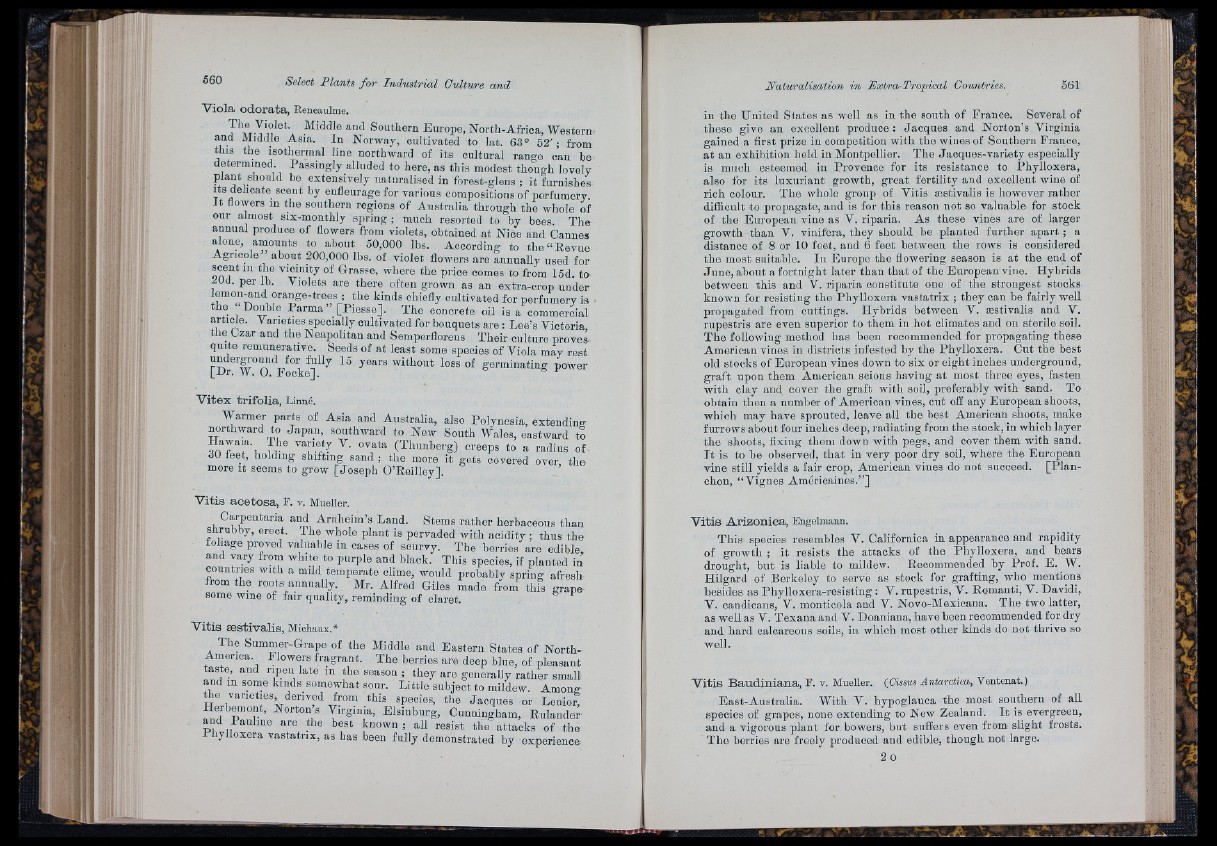
íi'
i
Viola odorata, Eeneaulme.
Southern Europe, N orth-Africa, Western
and Middle Asia. In Norway, cultivated to lat. 63° 52'; from
fois the isothermal line northward of its cultural range can be
determined. Passingly alluded to here, as this modest though lovely
plant should be extensively naturalised iu forest-glens ; it furnishes
Its delicate scent by enfleurage for various compositions of perfumery
I t flowers in the sonthern regions of Australia through the whoie of
our almost six-monthly spring ; much resorted to by bees The
annual produce of flowers from violets, obtained at Nice and Cannes
alone, amounts to abont 50,000 lbs. According to the “ Revue
Agricole about 200,000 lbs. of violet flowers are annually used for
scent in the vicinity of Grasse, where the price comes to from 15d. to
^ d . per lb. Violets are there often grown as an extra-crop under
lemon-and orange-trees ; the kinds chiefly cultivated for perfumery is
f- 7 ® 7 “™ “ ’ [Pousse]. The concrete oil is a commercial
a rtid e . Varieties specially cultivated for bouquets are : Lee’s Victoria,
the Czar and the Neapolitan and Semperflorens Their culture proves
quite remunerative. Seeds of at least some species of Viola may rest
p o c k e ^ ^ 15 years without loss of germinating power
V itex trifolia, Linné.
Warmer parts of Asia and Australia, also Polynesia, extending
northward to Japan, southward to New South Wales, eastward to
k (Thunberg) creeps to a radius of
30 feet, holding sluftmg sand ; the more it gets covered over the
more it seems to grow [Joseph O’Reilley]. ’
Vitis aoetosa, P. v. Mueller.
Carpentaria and Arnlieim’s Land. Stems rather herbaceous than
shrubby, erect. The whole plant is pervaded with acidity ; thus the
foliage proved valuable in cases of scurvy. The berries are edible
and vary from white to purple and black. This species, if planted in
countries with a mild temperate clime, would probably spring afresh
from the roots annually. Mr. Alfred Giles made from tlifs grape
some wine of fair quality, reminding of claret.
Vitis æstivalis, Michaux.*
The Summer-Grape of the Middle and Eastern States of North-
America Flowers fragrant. The berries are deep blue, of pleasant
taste, and ripen late m the season ; they are generally rather small
and m some kinds somewhat sour. Little subject to mildew. Among-
the varieties derived from this species, the Jacques or Lenior)
Herbemont, Norton s Virginia, Elsinburg, Cunningham, Rulander
a to Pauline are the best known; all resist the attacks of the
Phylloxera vastatrix, as has been fully demonstrated by experiencein
the United States as well as in the south of France. Several of
these give an excellent produce : Jacques aud Norton’s Virginia
gained a first prize iu competition with the wines of Southern France,
a t an exhibition held in Montpellier. The Jacques-variety especially
is much esteemed iu Provence for its resistance to Phylloxera,
also for its luxuriant growth, great fertility and exoellent wine of
rich colour. The wliole group of Vitis æstivalis is however rather
difficult to propagate, and is for this reason not so valuable for stock
of the European vine as V. riparia. As these vines are of larger
growth than V. vinifera, they should be planted further apart ; a
distance of 8 or 10 feet, and 6 feet between the rows is considered
the most suitable. In Europe the flowering season is at the end of
Ju n e , about a fortnight later than th a t of the European vine. Hybrids
between this and V. riparia constitute one of the strongest stocks
known for resisting the Phylloxera vastatrix ; they can be fairly well
propagated from cuttings. Hybrids between V. æstivalis and V.
rupestris are even superior to them in hot climates and on sterile soil.
The following method has been recommended for propagating these
American vines in districts infested by the Phylloxera. Cut the best
old stocks of European vines down to six or eight inches underground,
graft upon them American scions having a t most three eyes, fasten
with clay and cover the graft with soil, preferably with sand. To
obtain then a number of American vines, cut off any European shoots,
which may have sprouted, leave all the best American shoots, make
furrows about four inches deep, radiating from the stock, in which layer
the shoots, fixing them down with pegs, and cover them with sand.
I t is to be observed, th a t in very poor dry soil, where the European
vine still yields a fair crop, American vines do not succeed. [P lan chon,
“ Vignes Américaines.”]
Vitis Arizonica, Engelmann.
This species resembles V. Californica in appearance and rapidity
of growth ; it resists the attacks of the Phylloxera, and bears
drought, but is liable to mildew. Recommended by Prof. E. W.
Hilgard of Berkeley to serve as stock for grafting, who mentions
besides as Phylloxera-resisting ; V. rupestris, V. Romanti, V. Davidi,
V. candicans, V. monticola and V. Novo-Mexicana. The two latter,
as well as V. Texana and V. Doaniaiia, have been recommended for dry
and hard calcareous soils, in which most other kinds do not thrive so
well.
V itis Baudiniana, F. v. Mueller. {Cissus Antarctica, Ventenat.)
East-Australia. With V. hypoglauca the most southern of all
species of grapes, none extending to New Zealand. I t is evergreen,
and a vigorous plant for bowers, but suffers even from slight frosts.
The berries are freely produced and edible, though not large.